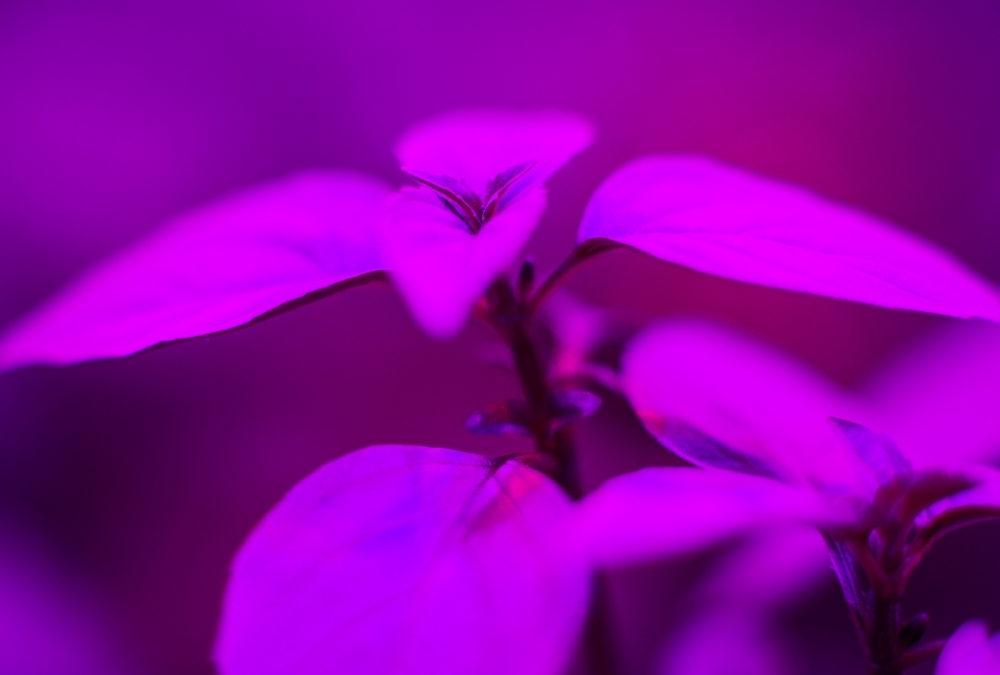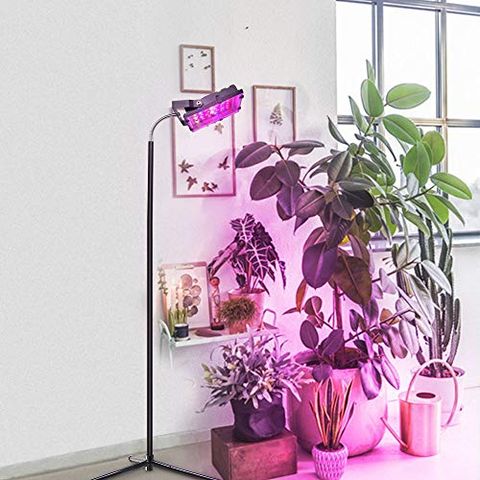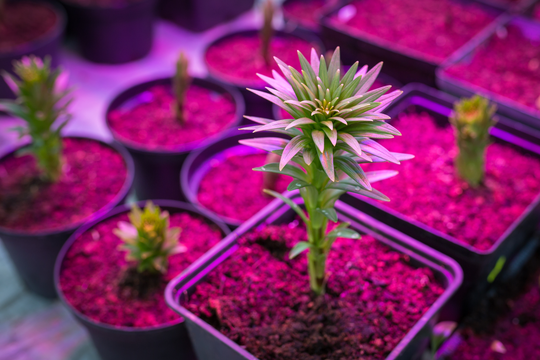We occasionally recommend products we love and might be paid a share of the sale.
When you think of grow lights, you think of the light sources mimicking the sunlight. So, the first thought that comes to your head is that these LED grow lights should be white. And, for the most part, the best full spectrum LED grow lights are either white or sometimes even red. However, that doesn’t stop the list of possible light spectrums that you will find the grow lights in.
One of the most (yet unusual) color of grow light that people deal with is purple. There are even instances where people are confused whether purple grow lights are even worth the hype they come with.
This article will discuss every last detail about purple grow lights, their benefits, their significance and whether they are good enough for your indoor plants or not.
What are the Science Behind Purple Grow lights?
The concept of indoor gardening, grow rooms, and grow lights are pretty new. It isn’t quite long that people have got into this concept as a whole. However, what you need to know is the science behind purple grow lights. Why are they used? Are the purple grow lights any good? Do they promote substantial growth of the plants?
These are some of the basic questions that most beginner growers have in their minds.
If you aren’t aware, the purple grow lights are made with a combination of red and blue grow lights that are fused to give the purple grow light. According to reports from the scientists, here’s why purple grow lights are important:
- The red grow lights in the combination are important for the flowering and fruiting procedure in the plants.
- The blue grow lights contribute to optimal vegetative growth in the plant.
So, the combination of the two promotes photosynthesis, plant growth and ensures optimal credibility in the plants, something that will ensure that your plants grow tall and healthy. During initial research with grow lights, researchers have found that while the individual impacts of the red and blue lights are quite profound on the indoor plants, their combined benefits are even better.
What are the benefits of purple grow light?
With the basic understanding of the individual grow lights out of the way, let us focus on the importance of purple grow lights. Be assured that they do come with their set of disadvantages too. However, it is the benefits that make it stand out from the crowd.
The primary reason purple LED grow lights work is because it isolates the blue and red grow light for optimal growth of the plants in question. This ensures that your plants get exactly what they need to grow and thrive in the environment they are growing in.
The ratio of the blue to the red LEDs in the setting also matters a lot when it comes to contributing to the plant’s health. Be assured that the ratio determines whether you have a light or dark purple from the setting. Each shade comes with its benefits, so finding the right one for your indoor plant is what matters in the end.
Which light color spectrum works better than purple?
Although indeed, the purple light spectrum works magnificently for the growth of indoor plants, there are some superior alternatives that one should be aware of.
Besides the blend of red and blue diodes, scientists have found that adding in a little extra bit of UV and IR light has proven benefits in improving the yield qualities to the next level. Typically, botanists are suggesting investing in lights that support a varied light spectrum so it meets the needs of every plant that you are likely growing.
Why are purple lights not always the best option?
As we have mentioned from the beginning of the discussion, blue, red and the combined purple lights bring in a lot of benefits. However, what you need to understand is the fact that the purple LED grow lights aren’t the end of the Earth. Sometimes, botanists suggest steering clear of them.
But, why? Here’s what you need to know:
-
They are not economical
We can’t stress this enough but purple grow lights are quite expensive. Compared to the other LED light settings, which are a lot cheaper, the purple lights don’t always make sense. Most of the users back in the day relied on the purple grow lights because they brought in a lot of benefits with them.
Now, compared to the standard LEDs, they don’t make much of a difference. Especially when it comes to energy efficiency, the purple LED grow lights don’t have a significant commercial impact, which is reason enough why they aren’t worth the price you pay.
-
Grow lights go beyond blue and red
Blue and red indeed grow lights impose their list of benefits that contribute to plant growth and eventual flowering and higher yield. However, what you need to understand is the fact that the growth of these indoor plants is reliant on more than just the blue and red grow lights.
UVA and UVB along with green and IR lights have been found to have proven benefits in promoting plant growth substantially. So, if you are sitting here stuck thinking, you just need blue and red grow lights for your plants, you are completely mistaken.
-
They aren’t pleasant
People who have dedicatedly used purple lights for their plants said that while it doesn’t bother in the beginning, that soon changes with direct exposure to the bright light. Besides the complaints of overheating, purple lights can also become very sharp for the eyes, making it difficult to be in the same room as them.
So, it goes without saying that if you don’t want that hassle or have a separate grow room for your plants, keeping purple lights is pretty much out of question. We’d highly recommend that you look into other options instead.
Why is LED Purple light so Uncomfortable to Human Eyes?
If you are a complete novice when it comes to LED grow lights and the whole shazam, you’d realize soon enough that the intensity of the purple grow lights makes them difficult to withstand. The Color Rendering Index is what determines that the purple lights are uncomfortable.
Typically, the CRI is what determines how natural the purple light looks or feels under different kinds of lighting. However, what you need to realize is the fact that purple light has a very sharp tangent to it, which is extremely unpleasant to one’s common vision. Hence, a human has a hard time withstanding the rough purple strobe from these LED grow lights, making them a difficult inclusion in the grow room.
Is it necessary to include a purple grow light?
With all the discussion on board, it is common for one to think, “Do you even need a purple grow light in your grow room?” And, to be fair, the answer is yes.
If you are growing different kinds of indoor plants that require light exposure during their vegetative or flowering stages, you must focus on introducing a high-quality purple light to the equation.
Not only does it reflect on the growth, but it also affects the stability of the plant’s health throughout the tenure. Be assured that there are more pleasant alternatives to the staple purple light, like the Valoya light, which has a slight pink tinge to it.
https://www.youtube.com/watch?v=SMWCdGH9zGE
So, 9 out of 10 times, the grow light might be purple. However, on other occasions, you won’t have to worry about the same to be an exact shade of purple time after time.
FAQs
Do the purple lights help plants grow?
Yes, the combination of the red and blue grow lights promotes plant growth and ensures that there are no lingering issues with the quality of the plants. The blue light spectrum helps with the vegetative stage while the red light spectrum contributes to the flowering stage of the plant.
Is purple grow light better than white?
Both purple and the staple white grow lights come with their own set of benefits. This means that you need to be wary of the requirements of your plant before you decide which one, you’d need. If you find the leaves wilting, it is a sign that the light exposure is not suitable for your indoor plant.
Which color grow light contributes to plant growth specifically?
It is the blue grow light that predominantly contributes to plant growth. This is because this has proven benefits during the vegetative stage. So, if you are considering growing an indoor plant, blue light is a must in the equation.
Conclusion
If you are way about using purple lights, we hope this article gives you all the insights that you are looking for. Although quite beneficial, purple lights come with a few limitations that you need to be wary of. Just ensure that you keep an eye out for the same without any questions asked.
I’m an avid gardener and cannabis enthusiast. You can usually find me in my garden caring for my plants or at my computer crafting helpful blogs for my readers.
Contents




